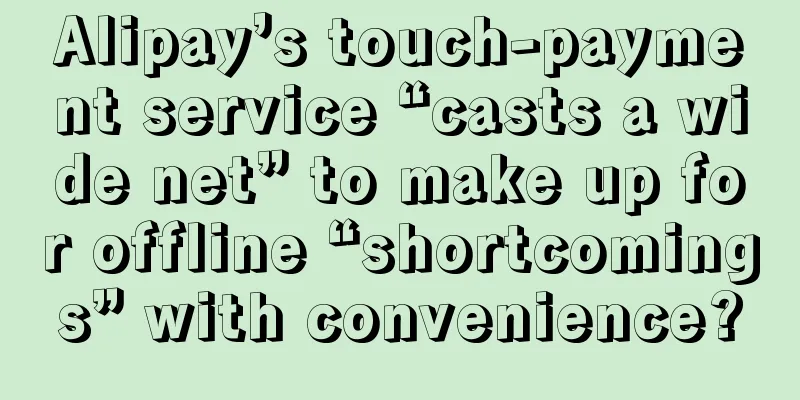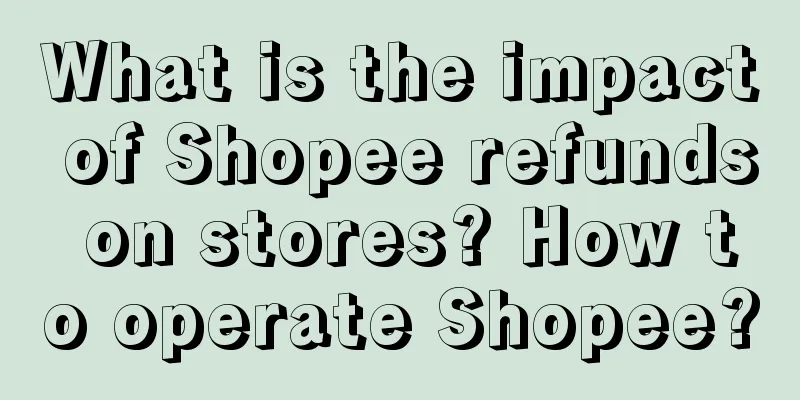Alipay’s touch-payment service “casts a wide net” to make up for offline “shortcomings” with convenience?

Just a few days before Taobao is about to launch WeChat payment, I went shopping at Wumart Supermarket and found a new device when checking out. After scanning the product code, I can choose Alipay to "touch and pay". I usually like the more convenient face scanning payment when shopping, but now there will be a more convenient option. Just touch the phone to this device and the payment is easily completed. In this "second wave" of digital payment battles, Alipay's "tap and pay" function is aimed at offline scenarios and will create waves in the payment world with its unique "tap and pay" experience. At the same time, Alipay joined hands with Meiyajia and many other convenience store chains to promote this function. If face-scanning payment allows us to pay by just scanning our faces, this function makes payment as fast as "checking in". This is not only an innovation in payment methods, but also an important "counterattack" by Alipay in its offline territory. If Taobao's support for WeChat Pay is seen as an offensive from its online competitors, this move is a proactive attack offline, which will help the former compete for the "traffic" high ground in the offline payment market. 01 Alipay "touch"1.1 Functional advantages and technological innovation1) Convenience Alipay's "touch and pay" function is a revolutionary breakthrough in payment methods. From the perspective of consumers, it adds a new form of payment for users. This function uses NFC (near field communication) technology to enable users to complete payment within 0.3 seconds, which is at least 5 times faster than the traditional scanning method. Even compared with face scanning payment, it is much more convenient. 2) Security Behind the convenience, Alipay has taken security into consideration. NFC technology has been widely used in subways, buses and other scenarios, and the public has a high degree of trust in it. When users use Alipay's "touch and pay" function in supermarkets, all transaction data is encrypted through NFC technology to ensure the security of the transaction. In recent years, especially many new energy vehicles have begun to be equipped with NFC keys, which has further made the public accept its safety. 3) Technical compatibility In terms of technical compatibility, Alipay's "touch and pay" function is perfectly compatible with mainstream NFC mobile phones on the market, including iOS and Android, covering a wide range of user groups. In addition to the user side, Alipay also ensures that its payment system is compatible with merchants' NFC payment terminals. This includes compatibility testing with various POS machines and payment hardware to ensure a smooth payment process. According to statistics, the number of devices supporting NFC function in the world has exceeded 2 billion. It is rumored that this year's new iPhone will have big moves in NFC, which will make the coverage of this technology more universal. 1.2 Industry Cooperation and Market DynamicsAlipay's "touch and pay" function is rapidly becoming a regular feature in the convenience store industry, and some netizens have discovered that many well-known convenience store chains have begun to support this function. According to incomplete statistics, more than 50 convenience store brands and tens of thousands of stores support this innovative function, including 7-Eleven, Tangjiu Convenience and Jinhu Convenience. 1) Brand cooperation There is no doubt that thanks to Alipay's long-term development in offline business, this function can be supported by these widely distributed convenience stores as soon as it is launched. In addition, in order to promote the "touch and go" function, Alipay has also launched various joint activities, which is also the reason why convenience stores and supermarkets support it at the first time. Such cooperation not only improves the visibility of Alipay in the offline payment market, but also greatly enriches the user's usage scenarios. By implementing "touch and pay" in convenience stores, a high-frequency payment scenario in daily life, Alipay will provide users with a faster and more convenient payment option, which will objectively optimize the offline payment experience. 2) User Experience In a high-frequency payment environment like convenience stores, users can use "touch and pay" to greatly free themselves from some cumbersome steps. Whether buying a cup of coffee or a bag of snacks, payment can be completed in an instant. This convenience not only improves user satisfaction, but also increases their loyalty to convenience store brands. The mainstream offline payment methods are code scanning and face scanning. The former requires users to open their mobile phones and click on the payment code, or click on the scanning function to scan the store's payment code. The whole process requires at least three to five operations. Face scanning is relatively convenient, but it also requires users to pose in front of the camera and follow the specified angle to successfully pay. In terms of user experience alone, the touch-and-pay method is obviously the best of the three. 1.3 Potential changes in the market landscapeJust like Taobao will support WeChat payment, the changes in the mobile payment market are still continuing. After years of development, the offline supermarket industry has become extremely mature, and a large part of citizens' daily consumption is solved through offline retail. In this process, the convenience of payment methods has always been directly related to user experience. In the early days, due to the lack of hardware equipment, QR codes that only needed to be "printed out and pasted" became the mainstream choice for offline supermarkets. As users use mobile payments more frequently offline, new payment methods such as face scanning payment and touch payment have emerged, which are options with better experience and security. As a huge consumption scenario, the penetration and competition of both Alipay and WeChat into offline retail formats will continue into the next wave of consumption. 02 Offline advantages of WeChat Pay2.1 “Normandy Landings”In 2016, WeChat Pay gained 800 million new users overnight through the interactive marketing strategy of the Spring Festival Gala, a strategy that was vividly called the "Normandy Landing." This move not only brought huge user growth to WeChat Pay, but also marked an important breakthrough in the field of mobile payments. As one of the most important TV programs in China, the Spring Festival Gala has extremely high ratings and influence. Through interactive marketing on this platform, WeChat Pay has successfully made its brand image deeply rooted in the hearts of the people, while also demonstrating its innovation capabilities and market insights in the field of mobile payments. In recent years, WeChat Pay's offline market share has increased year by year. According to a Shangpu Consulting report, WeChat Pay's offline market share will be close to Alipay in 2023. Behind this change is WeChat Pay's intensive cultivation of offline scenarios and its accurate grasp of user payment habits. For example, WeChat Pay has launched a "smart retail" solution by cooperating with retail giants, allowing users to enjoy a smoother payment experience when shopping. In addition, WeChat Pay has further attracted users to use its payment service by launching promotional activities such as "WeChat Pay Day". 2.2 QR code paymentQR code payment is one of the key factors for WeChat Pay's success in the offline market. As a social application, WeChat's QR code usage rate is much higher than other payment tools. Users frequently use QR codes to add friends, join group chats, follow public accounts, and other operations in WeChat. Driven by the power of habit, users are more inclined to use WeChat to scan QR codes when paying. For example, when a convenience store asks you to scan a QR code, people will subconsciously open WeChat without thinking, and only old users of Alipay will open the Alipay APP, which they rarely use, and then scan the code. How strong is the power of habit? According to iResearch data, the average daily number of WeChat QR code payment transactions exceeded 1 billion in 2023, more than three times that of 2019, fully demonstrating the popularity of QR code payment among users. In addition, WeChat Pay continues to launch innovative features, such as "WeChat Pay Points", to provide users with credit payment services, further enhancing user stickiness. Through these data and reports, we can see the rapid development and market leadership of WeChat Pay in the field of mobile payments. 03 Can “convenience” win?In the new battlefield of mobile payment, WeChat Pay and Alipay have always been the two main competitors. WeChat Pay has rapidly expanded its user base with its interactive marketing strategy of the Spring Festival Gala and the popularity of QR code payment, while Alipay, with its first-mover advantage and marketing promotion, has also made many new and old Alipay users accustomed to using the latter to scan codes. In addition, whether it is face scanning payment or touch payment, they are all new products from the perspective of more convenient payment methods. Whether they are popularized is related to whether they can further consolidate their own brand image and advantages. 3.1 “Tap to Pay”Alipay's "touch and pay" function allows users to pay quickly by simply touching their mobile phone to a payment device that supports NFC technology. This innovation greatly simplifies the traditional QR code payment process. For example, in a large supermarket in Shanghai, after introducing "touch and pay", the average checkout time of customers was shortened from 30 seconds to 10 seconds, significantly improving the shopping experience of customers. 3.2 MarketingHowever, the promotion of this function also faces the challenge of hardware dependence. In order to overcome the increased costs for merchants to install NFC payment devices, Alipay has taken positive measures. For example, Alipay provides up to 50% equipment subsidies for the first batch of merchants to install NFC devices, and also launched preferential installation services, which reduces the installation cost by about 30%. In addition, Alipay has also launched exclusive marketing activities for "tap payment", such as "5 yuan off for first time use of touch payment", which attracted more than 1 million users in the early stage of promotion. The launch of "touch and pay" is also an important strategic move for Alipay in the offline payment market. Through this function, Alipay not only enhances the user experience, but also deepens cooperation with merchants. According to Alipay's data in 2023, after the introduction of "touch and pay" by merchants, the average transaction volume increased by 15%, and the customer return rate increased by 20%. It effectively expanded Alipay's penetration in the offline market and will help Alipay gain a favorable position in the fierce market competition. These data and examples show that “touch and pay” not only brings convenience to users, but also brings significant economic benefits to merchants and Alipay itself. 04 Future Prospects of Offline Payment MarketAs digital transformation accelerates, we are rapidly moving towards a "cashless society", and competition in the offline payment market is intensifying. Alipay's "touch to pay" function is rapidly becoming the new favorite in the payment field with its unparalleled convenience and cutting-edge technology. According to data, users of Alipay Quick Payment are relatively young, with about 60% born after 1980, and only 5% over the age of 40. The launch of Alipay's "touch and pay" is not only a manifestation of technological innovation, but also a revolutionary subversion of traditional payment methods. Users can now complete payments with a simple touch without unlocking their phones. This unprecedented convenience is redefining consumers' payment experience. Looking ahead, as the “touch and pay” function becomes more popular, the competition landscape of the offline payment market is expected to change. Alipay, with its continued investment in technological innovation and user experience, is expected to further consolidate its advantages in the competition with WeChat Pay. Looking back, WeChat Pay, with its strong influence in the social networking field and users' familiarity with QR code payment, is expected to maintain its position in the offline payment market. However, with the promotion of Alipay's "touch payment" and the gradual change of user habits, the competition between the two payment giants will become more intense. Ultimately, the biggest beneficiaries of this competition will be consumers, who will enjoy more convenient, secure and diverse payment options. With the continuous advancement of technology and the continuous evolution of the market, the future of the offline payment market will undoubtedly be full of infinite possibilities, bringing more innovation and surprises to consumers. Text丨Chen Congshi Tianhao |
<<: The plastic turtle in the live broadcast room controls young people
>>: Daolang’s video live broadcast taught an important lesson to brand marketing
Recommend
Xiaohongshu high-quality delivery notes production standards
This article mainly introduces how to formulate hi...
What does it mean to pick up your order at Shopee? How does it work?
There are many ways of shipping on the Shopee plat...
How to sign up for Amazon Prime Day? How to increase the chance of getting approved?
The specific time of Amazon Prime Day has not been...
How can a complete amateur become a Xiaohongshu blogger? 3 tips from my recent experience in blogging!
The content of this article comprehensively and sy...
The value and significance of brand user portraits
User portrait is an important way to achieve preci...
Build a personal brand IP profit model
Previously, we shared how to build a personal bran...
What is the best time to buy Amazon Lightning Deals? How long does it take for Amazon Lightning Deals to happen?
As one of the world's largest e-commerce platf...
Who was cured by the boring live broadcast?
Looking back at the live broadcast content ecology...
How to be a seller on WishGo online shopping platform? Current status and analysis of WishGo platform
In the wave of digitalization, WishGo online shopp...
How do tea, fresh produce, and traditional nourishing businesses with strong categories and weak brands make a fortune quietly in the live broadcast room?
As a traditional industry that is less affected by...
iPad Pro's new ad is called the most controversial idea of 2024
The most controversial iPad Pro advertisement in 2...
What does an Amazon merchant manager do? What is an account manager?
Today I will introduce you to the content of Amazo...
What does Amazon ad group mean? What is an ad portfolio?
If Amazon merchants want to promote their products...
If you want to build your own personal IP, just follow these 4 steps.
Nowadays, everyone is talking about building a per...
I turned self-discipline into a business and I earned 20 million a year
Bao Ruiming's company has been selling self-di...









